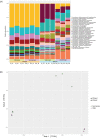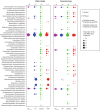Host range of antibiotic resistance genes in wastewater treatment plant influent and effluent
- PMID: 29514229
- PMCID: PMC5939699
- DOI: 10.1093/femsec/fiy038
Host range of antibiotic resistance genes in wastewater treatment plant influent and effluent
Abstract
Wastewater treatment plants (WWTPs) collect wastewater from various sources for a multi-step treatment process. By mixing a large variety of bacteria and promoting their proximity, WWTPs constitute potential hotspots for the emergence of antibiotic resistant bacteria. Concerns have been expressed regarding the potential of WWTPs to spread antibiotic resistance genes (ARGs) from environmental reservoirs to human pathogens. We utilized epicPCR (Emulsion, Paired Isolation and Concatenation PCR) to detect the bacterial hosts of ARGs in two WWTPs. We identified the host distribution of four resistance-associated genes (tetM, int1, qacEΔ1and blaOXA-58) in influent and effluent. The bacterial hosts of these resistance genes varied between the WWTP influent and effluent, with a generally decreasing host range in the effluent. Through 16S rRNA gene sequencing, it was determined that the resistance gene carrying bacteria include both abundant and rare taxa. Our results suggest that the studied WWTPs mostly succeed in decreasing the host range of the resistance genes during the treatment process. Still, there were instances where effluent contained resistance genes in bacterial groups not carrying these genes in the influent. By permitting exhaustive profiling of resistance-associated gene hosts in WWTP bacterial communities, the application of epicPCR provides a new level of precision to our resistance gene risk estimates.
Figures



Similar articles
-
Bacterial hosts of clinically significant beta-lactamase genes in Croatian wastewaters.FEMS Microbiol Ecol. 2024 May 14;100(6):fiae081. doi: 10.1093/femsec/fiae081. FEMS Microbiol Ecol. 2024. PMID: 38796694 Free PMC article.
-
Prevalence and proliferation of antibiotic resistance genes in two municipal wastewater treatment plants.Water Res. 2015 Nov 15;85:458-66. doi: 10.1016/j.watres.2015.09.010. Epub 2015 Sep 7. Water Res. 2015. PMID: 26372743
-
Characterisation of microbial communities and quantification of antibiotic resistance genes in Italian wastewater treatment plants using 16S rRNA sequencing and digital PCR.Sci Total Environ. 2024 Jul 10;933:173217. doi: 10.1016/j.scitotenv.2024.173217. Epub 2024 May 13. Sci Total Environ. 2024. PMID: 38750766
-
Antibiotic resistance genes identified in wastewater treatment plant systems - A review.Sci Total Environ. 2019 Dec 20;697:134023. doi: 10.1016/j.scitotenv.2019.134023. Epub 2019 Aug 22. Sci Total Environ. 2019. PMID: 31479900 Review.
-
Antibiotic resistant bacteria and genes in wastewater treatment plants: From occurrence to treatment strategies.Sci Total Environ. 2022 Sep 10;838(Pt 4):156544. doi: 10.1016/j.scitotenv.2022.156544. Epub 2022 Jun 6. Sci Total Environ. 2022. PMID: 35679932 Review.
Cited by
-
Removal of Sulfonamide Resistance Genes in Fishery Reclamation Mining Subsidence Area by Zeolite.Int J Environ Res Public Health. 2022 Apr 2;19(7):4281. doi: 10.3390/ijerph19074281. Int J Environ Res Public Health. 2022. PMID: 35409961 Free PMC article.
-
Unraveling the diversity of sedimentary sulfate-reducing prokaryotes (SRP) across Tibetan saline lakes using epicPCR.Microbiome. 2019 May 4;7(1):71. doi: 10.1186/s40168-019-0688-4. Microbiome. 2019. PMID: 31054577 Free PMC article.
-
Bacterivorous Ciliate Tetrahymena pyriformis Facilitates vanA Antibiotic Resistance Gene Transfer in Enterococcus faecalis.Antibiotics (Basel). 2025 Apr 28;14(5):448. doi: 10.3390/antibiotics14050448. Antibiotics (Basel). 2025. PMID: 40426515 Free PMC article.
-
Increased Antimicrobial and Multidrug Resistance Downstream of Wastewater Treatment Plants in an Urban Watershed.Front Microbiol. 2021 May 24;12:657353. doi: 10.3389/fmicb.2021.657353. eCollection 2021. Front Microbiol. 2021. PMID: 34108949 Free PMC article.
-
Horizontal gene transfer from genetically modified plants - Regulatory considerations.Front Bioeng Biotechnol. 2022 Aug 31;10:971402. doi: 10.3389/fbioe.2022.971402. eCollection 2022. Front Bioeng Biotechnol. 2022. PMID: 36118580 Free PMC article.
References
-
- Altschul SF, Gish W, Miller W et al. Basic local alignment search tool. J Mol Biol. 1990;215:403–10. - PubMed
-
- Auerbach EA, Seyfried EE, McMahon KD. Tetracycline resistance genes in activated sludge wastewater treatment plants. Water Res. 2007;41:1143–51. - PubMed
-
- Bengtsson-Palme J, Hammaren R, Pal C et al. Elucidating selection processes for antibiotic resistance in sewage treatment plants using metagenomics. Sci Total Environ. 2016;572:697–712. - PubMed
Publication types
MeSH terms
Substances
LinkOut - more resources
Full Text Sources
Other Literature Sources
Medical

